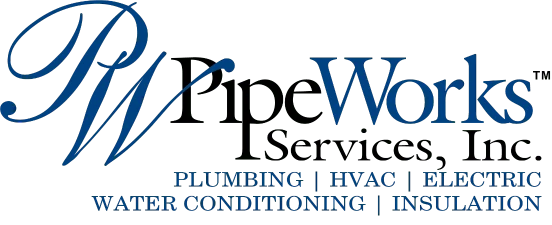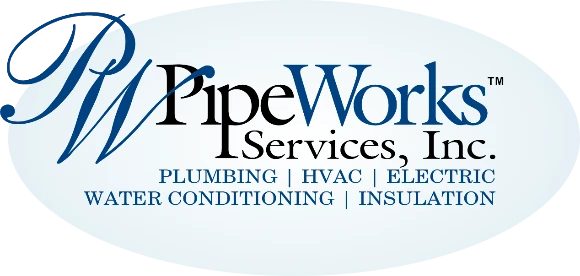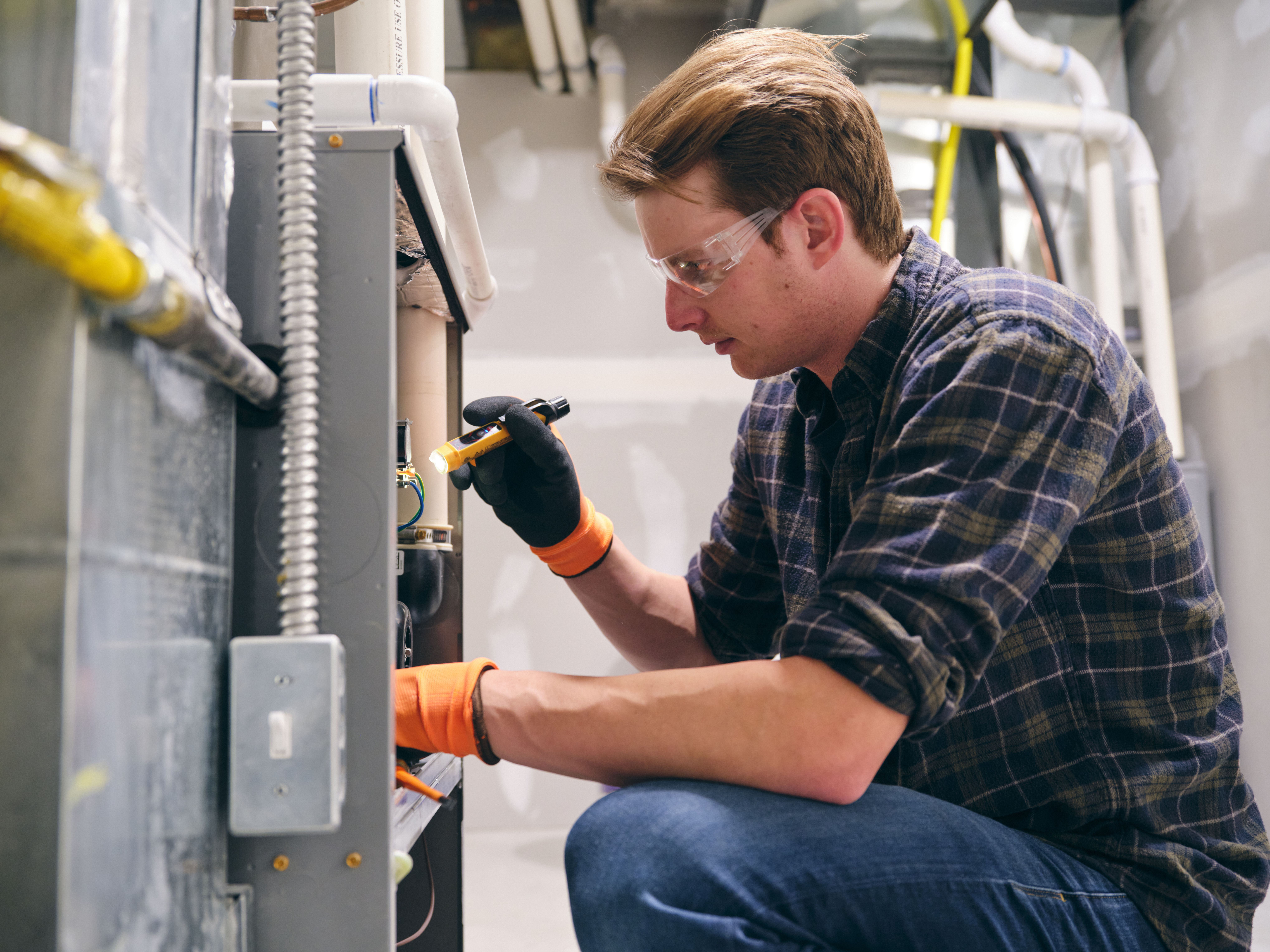Your furnace is the heart of your HVAC system while the thermostat is the brain. The thermostat can detect a change in your home temperature. If the temperature dips below a desired level, your thermostat detects it and spurs the furnace into action. The burners are cued to light the ignition, which uses fuel and air inside the burner to produce a steady flame. The combustion process creates heat, which is absorbed through the heat exchanger, and the blower then drives the heated air through your ducts to warm your home.
Most home furnaces have the following parts:
- Ignition
- Burners
- Heat exchangers
- Blower
- Flue
- Plenum
The flue and the plenum work together to ensure that the warm air being circulated is safe and efficient. The flue filters out the harmful gases that are produced during the combustion process while the plenum moves air inside, circulates it throughout the building, and then removes it.
Now that you know the basics, let’s examine the two types of furnaces commonly used in most homes: gas and electric.
Gas Furnaces
Any home heating appliance that runs on natural gas is a gas furnace. Gas is ignited inside, where it heats up as the air goes inside. The air is heated through the heat exchanger and distributed through the blower. This is how your home is heated. Any remaining gas waste goes through the flue and is directed out of your home.
The Five Stages of Your Gas Furnace
As a homeowner, you should get familiar with your gas furnace. A good knowledge of every step in the heating cycle can give you an overview of how your furnace works to help you spot potential problems early on.
The thermostat senses when the temperature drops and sends a command to the furnace to kick on. You’ll need to program your thermostat to your desired temperature to let your heating system know when it’s time to come on. At the thermostat’s prompting, the furnace wakes up. The gas travels through an open valve towards the burner. Cold air passes through the blower and onto the burner, where it’s heated for home use.
Now it’s time to start the ignition. During this phase, the pilot light ignites the burner, which warms up incoming air. That same air is dispatched to the ducts and distributed throughout your home. The flue vents any resulting gases from the combustion process. Once done, the cycle is repeated.
The mantra for the final stage should be “warm air out, cold air in.” Essentially, this is what happens when the entire cycle gets repeated. The warm air exits the ductwork and is distributed throughout your home for personal comfort. When that air cools, a fresh batch of warm air comes through to replace it, and the cycle continues.
Now that you know the scoop on gas furnaces, let’s move on and explore electric furnaces.
Electric Furnaces
Electric furnaces operate similarly to gas furnaces. The main difference is that they rely on electricity rather than gas to heat your home, so there’s no need to worry about gas leaks. Electric furnaces use heating elements rather than gas burners to create heat.
As with the gas furnace, electric furnaces use commands from thermostats to kick on. Most electric furnaces have two primary parts: the air handler and the heating coils. These parts work together to warm incoming cold air and push it into the ducts to spread throughout the home.
Deciding on the best furnace type for your home takes a little headwork. We’ll help you decide by weighing the pros and cons of each.
Electric Furnace vs Gas Furnace: Which One Is Better?
Youll need to consider several factors when choosing a new furnace for your home, including the size of your home, required routine maintenance, life expectancy, and energy efficiency standards. Initial costs for parts and installation should be factored into your decision, too. You should also consider the climate of your region. If you have colder winters, your best bet would be a gas furnace because it’s more effective and efficient.
Below are the pros and cons of each furnace type.
Electric Furnace
On average, electric furnaces are cheaper to install. Initial costs for the unit plus installation are from $2,000 to $4,000. These are the advantages of owning an electric furnace:
- No gas lines or flue venting needed
- Low maintenance unit
- Longer lifespan of at least 20 years
- Greater noise resistance
- Less costly repairs
But like most machines, electric furnaces have some drawbacks:
- More time needed to produce heat
- Insufficient heat
- Increased energy costs
At first glance, an electric heater seems to be an ideal choice. They’re cheap and easy to install and have fewer maintenance issues. When you factor in higher monthly utility bills, however, an electric furnace might not be as ideal as you think.
Gas Furnaces
The average costs for purchasing and installing a gas furnace range from $4,500 to $6,000, making them more expensive than their electric counterparts. Although propane is used for some, the most common fuel source is natural gas. They have the following perks:
- Lower energy costs
- Heats your home quickly and efficiently
- Keeps your home warmer for longer periods
As popular as they are, gas furnaces can come with disadvantages, too. They have the following drawbacks:
- Risk of carbon monoxide poisoning
- Less noise resistance
- Higher maintenance needs
- Expensive to purchase and install
- Shorter lifespan of only 15-20 years
It’s not uncommon for gas furnaces to make a low humming noise while heating your home. It’s because they rely on extra exhaust fans to vent gas safely out of your home. Your home will be warmed up safely and efficiently, and you won’t have to worry about any extra gas lingering inside your home.
Any excessive noises such as booming bangs and pops, loud rumbling, or high-pitched squealing are not ordinary for a gas furnace. They are indicative of a greater problem that should not be ignored. If it doesn’t sound normal, call a professional immediately.
The Bottom Line
Although the cons might seem to outweigh the pros for gas furnaces, they remain a popular choice for most homeowners. Natural gas is cheaper to use than electric furnaces, which costs $3.87 per 100,000 BTU compared to natural gas, costing only $1.21 per 100,000 BTU. That’s a difference of roughly $2.66.
However, there are some great reasons gas furnaces continue to be so popular. Gas is cheaper to use and is more efficient at heating your home. Those who live in milder climates or who are worried about the potential risks associated with gas appliances might prefer electric furnaces instead.
At Pipe Works Services, we do furnace repair and installation as well as heat pump installation and maintenance for your Chatham, NJ home. Visit Pipe Works Services today to learn more.





